Price:₹23,000.00
Chadar Trek In Leh – over the Zanskar River range of Ladakh-2024- Complete information, Itinerary, Costs Date
Your trek journey started with Himalayan Hikers, beautiful mountain town of Leh, all our trekker reach Leh by flight this is best option to you reach to Leh, altitude is 11400 feet above sea level, the trek beautiful Zanskar River which liws totally frozen during the December to Feb, Peak Winters Trek, So, probably the best time to do Chadar Trek is February because the ice remains harsh and stable. Trek starts from the freezing point of Zanskar River and that is Chilling.
Therefore, the “Chadar trek” is also known as “The Frozen River Trek”. This Trek is over a frozen river in the Zanskar region of Ladakh and it is different from all other treks in the Himalayas.
The snow appears as a thick sheet of snow, therefore, it is called “Chadar trek” and it is one of the trickiest treks in the world which is done in peak winter months. On this trek explore the Zankari culture and get to know about it in close proximity and the main highlight of this Frozen River Trek is a completely frozen waterfall “Nerak”.
The Chadar Trek is a popular winter trek in the Zanskar region of Ladakh, India. Here are some highlights of the trek:
- Trekking on the frozen Zanskar River: The highlight of the Chadar Trek is the experience of walking on the frozen Zanskar River, which transforms into a thick sheet of ice during the winter months.
- Breathtaking views: The trek offers breathtaking views of the frozen landscape, towering mountains, and the gushing river beneath the ice.
- Cultural experience: The trek also offers a unique cultural experience, as trekkers get to interact with the local Zanskaris and witness their way of life in the harsh winter conditions.
- Adventure: The Chadar Trek is a challenging trek that requires physical endurance and mental toughness. Trekking on the slippery ice, crossing icy-cold streams, and camping in freezing temperatures make it an adventure of a lifetime.
- Photography opportunities: The trek offers numerous opportunities for photography enthusiasts to capture stunning landscapes and unique cultural experiences.
Overall, the Chadar Trek is a must-do trek for adventure and nature lovers who are up for a challenging winter trekking experience.
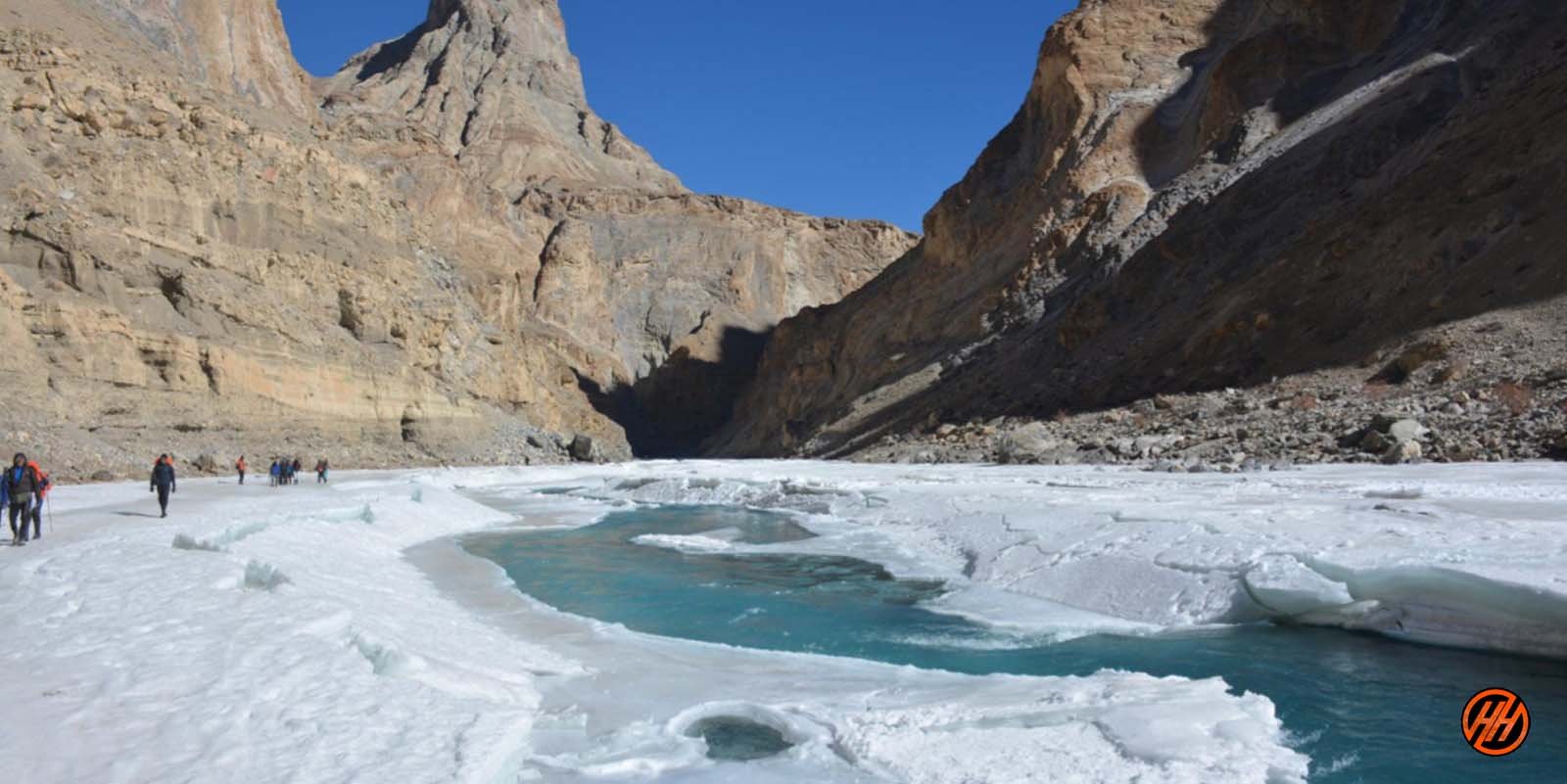
Ice Covering and Freezing Cold in Chadar Trek
The Chadar trek is over a frozen river and the ice can turn dangerous sometimes but can also be safe the other times. But, it is important to find a safe path over the perilous sheet of ice.
During the trek, you do not camp here at the meadows or the forest clearings but inside the caves which are present along the banks or you set up the tents at stable ice.
Here, the temperature remains chilly and freezing (-20) and falls down at night, so keep warm layers to protect the body against chilly cold and prevent the freezing of blood.
Best Time to Visit Chadar Trek
The best time to do the Chadar Trek is during the winter months, from January to February, when the Zanskar River freezes and forms a thick sheet of ice that is suitable for trekking. During this time, the weather is cold and dry, with clear blue skies and minimal precipitation.
It is important to note that the timing of the trek also depends on the weather conditions and the formation of the ice sheet. It is essential to have experienced guides and a reliable trekking organization to provide up-to-date information on the ice conditions and weather forecast.
Additionally, it is recommended to plan the trek in advance and book with a reputable trekking organization like Himalayan Hikers Trekking Organization to ensure availability and to have the necessary permits and logistics in place.
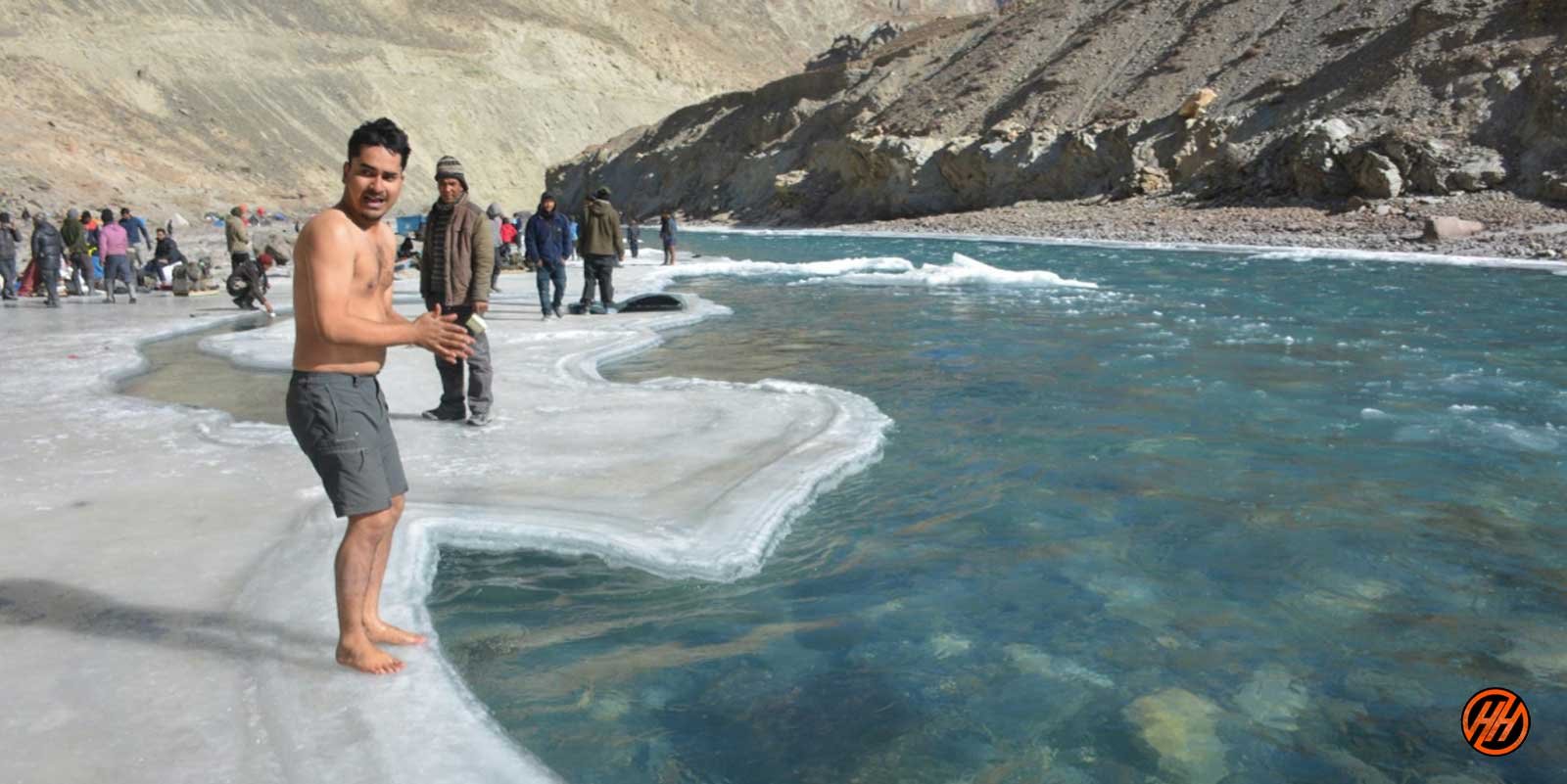
Be Aware During Chadar Trek (Not for Beginners)
You need to be very aware of the stability of ice and conditions below the feet for a safe trek. Sometimes the ice isn’t stable and the choices go wrong so walk carefully if suddenly a crack appears to go fast to the place where the ice is
So, choose a camping spot wisely after properly analyzing the area.
Here are some tips to do Chadar Trek –
Analyze the ice sheet conditions.
Avoid the cracks in the ice.
Walk carefully on the slippery areas.
Run immediately to a stable area if a sudden crack appears under your feet.
Walk on the places with a coating of snow.
Choose camping spots wisely.
Alcohol and smoking are not allowed in during the trek
Level- Difficult
During the trek, proper conditioning & training of body required
Need proper gear & clothing for sub-zero temperature
Shoes are the single most important equipment.
High Altitude requires proper acclimatization. Of base camp Leh
Beautiful landscapes so carry good photo gear & Extra battery backup.
Travel headlight
The backpack should not exceed 12 kg.
Long Gumboots are mandatory to all trekker
About Leh – Ladakh – The Land of High Passes
Area: 98,000sq km
Altitude: 7,500m Max.
Population: 250,000
Religion: Buddhism, Islam. Hindu
Geographical Status: Cold Desert
Across the Kashmir Valley and over the famous Zoji La pass lies Ladakh, the Land of High Passes. It is a magical land, so completely different from the green landscape of some other parts of the Himalayas. It is nature at its extreme. A land of freezing winds and blazing sunlight, Ladakh is a cold desert lying in the rainshadow of the Great Himalayas and other smaller ranges. Little rain and snow reaches this dry area, where the natural forces have created a fantastic landscape.
Ladakh forms part of the state of Jammu and Kashmir in India. Parts of Ladakh are under the illegal occupation of Pakistan and China. The border of Ladakh touches those of Afghanistan, Pakistan, China, the Kashmir Valley (India) and Himachal Pradesh (India). This region is made up of two administrative districts — Leh District, with its headquarters at Leh, and Kargil District, with its headquarters at Kargil –and covers a total area of about 59,000 square kilometers.
Ladakh is at an average elevation of 2,700 m to 4,200 m. The aridity of this region is due to its location in the rainshadow area of the Great Himalayas, elevation and radiation of heat from the bare soil. The most striking physical feature of Ladakh, however, is the parallelism of its mountain ranges. The region is extremely dry, with an annual rainfall as low as 10cubic centimeter.
In Ladakh, large rivers and their tributaries have carved deep gorges far below their steep banks. However, their water is not of much use as the terraced fields lie high above the gorges.
Until the advent of the aircraft, Ladakh could only be reached over dangerous, high passes. The Zoji La pass connecting Ladakh to Kashmir is at 14,000 ft and is the lowest approach from the west. The southeast approach has to cross the 18,200 ft high Tanglang La. And to the north lie the Saser La and Karakoram passes, gateways to Central Asia from where trading caravans used to come for many centuries.
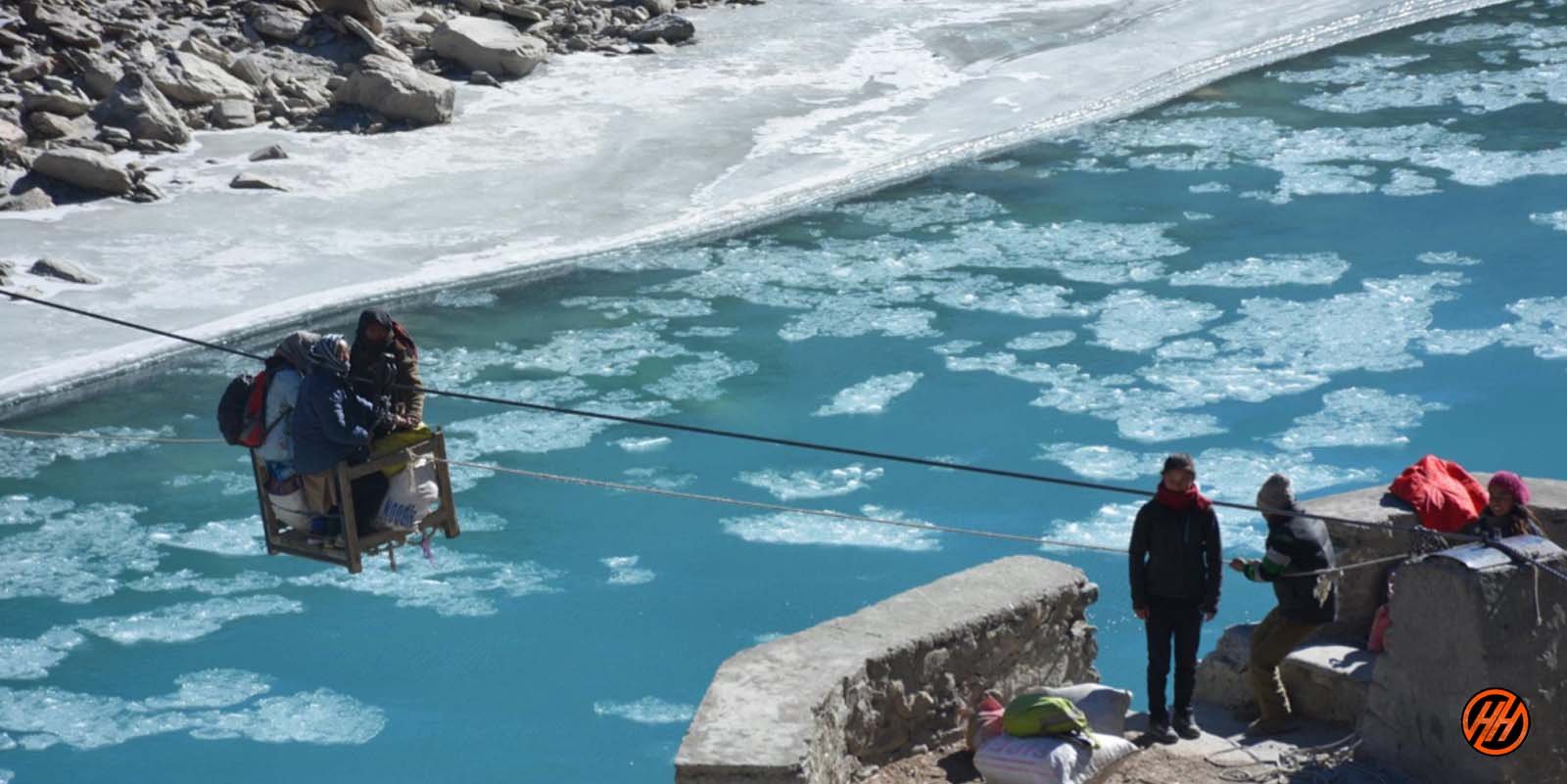
Altitude we are going to cover in Chadar Trek
Leh – 3500 Meters
Tsomo Paldar camp – 3200 Meters
Tibb Cave camp – 3300 Meters
Nerak camp – 3400 meters
The temperatures during the Chadar Trek
The temperatures during the Chadar Trek can be quite cold, as it takes place during the winter months when the region is covered in snow and ice. The average temperatures during the trek range from -10°C to -20°C (14°F to -4°F) during the day, and can drop to as low as -30°C (-22°F) at night. However, it is important to note that temperatures can vary depending on the weather conditions, altitude, and time of day.
It is crucial to have proper clothing and gear to stay warm during the trek, including warm base layers, a down jacket, insulated pants, waterproof gloves, and a warm hat. Additionally, it is important to stay hydrated and eat nutritious food to maintain energy levels and stay warm. Experienced trekking organizations like Himalayan Hikers Trekking Organization provide detailed information on what to wear and pack for the Chadar Trek to ensure a safe and comfortable trekking experience.
ATM Point & Mobile connectivity in Chadar Trek
ATM POINT: Hi trekker ATM available is Leh Withdraw money before your journey,
Mobile Connectivity: There will be available all networks only postpaid
Key Points of Chadar Trek
Duration: – 08 Nights 09 Days from Leh to Leh
Base camp: – Leh
Winter Temperature:- Day -5°C to -15°C) Night – 12° C to -20° C
Chadar trek – Altitude: – 11400 feet
Best Time: – Jan or Feb
Trek Level: – Difficult
Trek distance: – On foot 57 Km – By taxi 140 km
Group Size: – minimum of 05 people maximum of 15 people
Temperature
The winter temp. touches as low as minus 30 degree (Leh & Kargil) and minus 60 degree in (Drass) subzero temp. prevails from December to February throughout Ladakh, whereas, zero degree temp. is experienced during rest of winter months. This results in freezing of all conceivable water resources. During summers the maximum temp. increases from 20 degree C to 38 degree C in July and August
Clothing: Light/Medium woolens in summers to Heavy woolens in winter
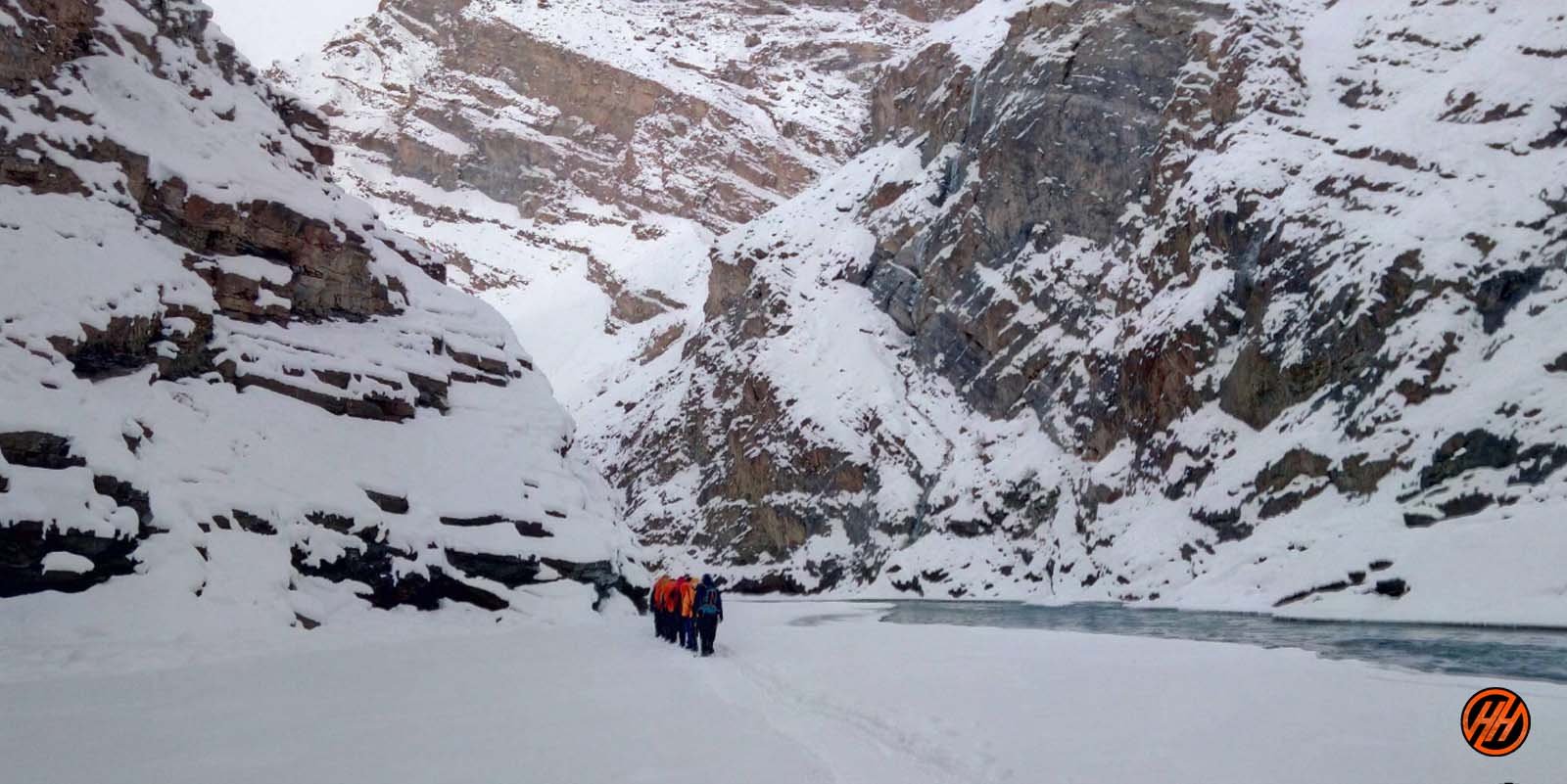
Languages Spoken
Ladakhi is the main language of Ladakh. Other languages spoken are Balti, Shina, Brokshat and Changshat. In hotels and restaurants, staffs speak English and Hindi, while tourist guides are well versed with the language.
Key Points about Chadar Trek
– Level: Difficult (so first-timers trekkers should avoid)
– Proper conditioning & training of body required
– Group size minimum of 05 maximum of 15 people
– Need proper Expedition gear & clothing for sub-zero temperatures?
– Shoes are the single most important equipment
– High Altitude requires proper acclimatization
– Phones don’t work on the trek, we are provide to you Radio Walkie Talkie for Communication
– Beautiful landscape so carry good photo gear (I couldn’t carry my best equipment)
– Travel light (my backpack was heavy at about 12 kg to 15 Kg )
– Keep an extra day in your itinerary for attempt to Chadar trek summit account for bad weather
– Alcohol and smoking is not allowed in during the Chadar Trek Expedition
Difficulty level
Because the top is relatively high in elevation, we strongly recommend a reasonable level of physical fitness. The arduous journey of Chadar trek winter hiking with longer distances and ascending elevations to be covered in a short span of time would require acclimatization. We advise trekkers to physically and mentally prepare themselves prior to this trek. Throughout the course, all groups will be guided by our experts for trekking equipment and any impending terrain.
Any medical assistance that is required will be provided at any point of the journey; however, trekkers must consult their professional care before beginning any trek. We also strongly advise trekkers to learn about altitude sickness and to notify our teams as soon as any symptoms appear.
Short Itinerary of Chadar Trek
Day 1:- Arrival at Leh – pickup to you from Airport drive to Hotel check in Rest and Acclimatization overnight stay Hotel
Day 2:- Trek Planning and Briefing – Acclimatization and Preparation- meet us our Himalayan Hikers Guide overnight stay
Day 3:- Medical Test Day in Leh
Day 4:- Drive from Leh to Bakula (70 km) (2 hours) same Day Trek Bakula to Shingra Koma 2/3 Hours overnight stay Camp
Day 5:- Trek from Shingra Koma to Tibba (16 km) (6/7 Hours) overnight stay Camp
Day 6:- Trek from Tibba to Nerak Waterfall (12 km )( 6/7 Hours) overnight stay Camp
Day 7:- Trek from Nerak to Tibba (16km ) (6/7 hours) overnight stay Camp
Day 8:- Trek from Tibba to Bakula (12 km) (6/7 hours) Same day Drive to Leh Hotel
Day 9:- After breakfast Depart from Leh
Permit and Passport
Tourist don’t require permit for Leh, however, all foreigners are required to be registered at Drass, Rumtse and Serchu if they are travelling overland. Those traveling by air get themselves registered at airport. Tourists are required to get permit for restricted areas like Tsomoriri, Tsokar and Pangong Lakes, Dhahanu and Nubra Valley, which can be obtained from District Magistrate, Leh, through Travel Agents at Leh.
Avoid acute mountain sickness
Acute mountain sickness can occur to any one at an altitude above 10,000 ft. above sea level, therefore, make it sure to take complete rest on the day of arrival.
How to Reach Leh or ladakh
Overland Approach
Overland Approach – The overland approach to Ladakh from Kashmir Valley via Kargil is approx. 434 Km, which remains open for traffic from early June to November. The most dramatic part of this road journey is the ascent up the 11,500 feet / 3,505 m high Zoji-La, the pass in the Great Himalayan Wall that serves as the gateway to Ladakh. The J & K State Road Transport Corporation (J&K SRTC) operates regular Deluxe and Ordinary bus services between Srinagar and Leh on this route with an overnight halt at Kargil. Taxis (cars and jeeps) are also available at Srinagar for the journey. Groups can charter Deluxe and A-class buses for Leh, Kargil or Padum (Zangskar) from the J & K SRTC at Srinagar.
Manali to Leh – Since 1989, the 473 km. Manali-Leh road has been serving as the second overland approach to Ladakh. Open for traffic from around mid-June to early October. This high road traverses the upland desert plateau of Rupsho, altitude ranges from 3,660m to 4,570m. A number of high passes fall enroute among which the highest one known as Taklang-La is world’s second highest motorable pass at an altitude of 17,469 feet/5,235m. Himachal Pradesh Tourism, HRTC and J & K SRTC operate daily Deluxe and Ordinary bus services between Manali and Leh. The bus journey between Leh and Manali takes about 19 hours or two days with an overnight halt in camps at Serchu or Pang. Shared taxis are also available both from Leh and Manali
Road Distances
Srinagar-Leh 434 Km
Manali-Leh 473 Km
Srinagar-Kargil 204 Km
Delhi-Leh 1047 Kms
Leh-Kargil 234 Km
Kargil-Padum (Zanskar) 240 Km
Leh-Deskit (Nubra Valley)118 Kms.
Credit Cards & ATM Machine
Credit cards are accepted by very few hotels and tour operators but there will be 2.5% service charge. The Jammu and Kashmir Bank and State Bank of India has placed ATM Machine in Leh. The State Bank of India accepts visa and mastero but this ATM is not very reliable. J&K Bank ATM is more reliable but accepts only Mastero.
Air Travel
Indian Airlines www.indian-airlines.nic.in operates regular flights to Leh from Delhi (fare USD 135), Four flights in a week from Jammu and once in a week from Chandigarh and twice from Srinagar. Jet Airways www.jetairways.com also operates daily flights between Leh-Delhi (fare USD 143).
Internal Transport
The cheapest way to travel within the region is by public buses, which ply on fixed routes according to fixed time schedules. The most comfortable and convenient though expensive mode of travel, however, is by taxi, which are available for hire on fixed point-to-point tariff. For visits to the newly opened areas of Nubra, Dah-Hanu, Tsomoriri, Tsokar and Pangong Lakes. It is mandatory to engage the services of a registered/recognized travel agency for making all the requisite arrangements including internal transport. Detailed information about bus schedules, taxi tariff, travel agencies can be obtained from the Tourist Office or Local travels guide “Reach Ladakh”, available at Book Shops.
Leh is the headquarter of Leh District, and the largest town of the region. It is located to the north of the Indus River at an elevation of 3600m above the sea level. The town is dominated by the nine-storey Namgyal Palace and Namgyal Tsemo (victory peak), built by Tashi Namgyal on his victorious in reunification of the Upper and Lower Ladakh. Leh became the capital of Stod (upper Ladakh) during the reign of king Graspa Bum- Lde,who ruled Ladakh from 1400 to 1430 AD. In the later period, Leh became an important center for trade in Central Asia. Leh remained merely a headquarter of Ladakh district until 1974, when Ladakh was opened for foreign tourists. Since then period Leh became the centre for tourism related activities in the region.
Fact File
Leh provides medium and lower class accommodation, with hundreds of guesthouses and hotels, which can suite every budget. Restaurants offer good multicuisine for a reasonable price. There are number of tour Operator/Travel Agents around the town, which look after traveler’s requirements.
Tour of Buddhist monasteries can be organized in one or two days, as all the famous monasteries are within a drive of one or two days from Leh. For information on monasteries please check monastery section of this web site.
There are several reasons why you may consider going on the Chadar Trek with the Himalayan Hikers Trekking Organisation:
- Experienced guides: Himalayan Hikers Trekking Organization has experienced guides who are familiar with the trek and the local area. They can provide valuable insights into the local culture and help ensure your safety during the trek.
- Safety measures: The Chadar Trek is a challenging trek that requires proper safety measures. Himalayan Hikers Trekking Organization takes safety seriously and provides necessary safety equipment like crampons, ropes, and ice axes, as well as a medical kit.
- Logistics: Organizing a trek like the Chadar Trek can be challenging, especially in a remote region like Zanskar. Himalayan Hikers Trekking Organization takes care of logistics like transportation, accommodation, and food, making the trek a hassle-free experience.
- Reputation: Himalayan Hikers Trekking Organization has a good reputation for organizing treks in the Himalayan region. They have received positive reviews from trekkers who have gone on their treks, making them a reliable choice for the Chadar Trek.
- Support staff: In addition to experienced guides, the Himalayan Hikers Trekking Organization also has a support staff to help with logistics and camp setup. This ensures that you can focus on the trek and enjoy the experience without worrying about the details.
Overall, going on the Chadar Trek with the Himalayan Hikers Trekking Organization can provide a safe and enjoyable trekking experience with the necessary support and guidance.

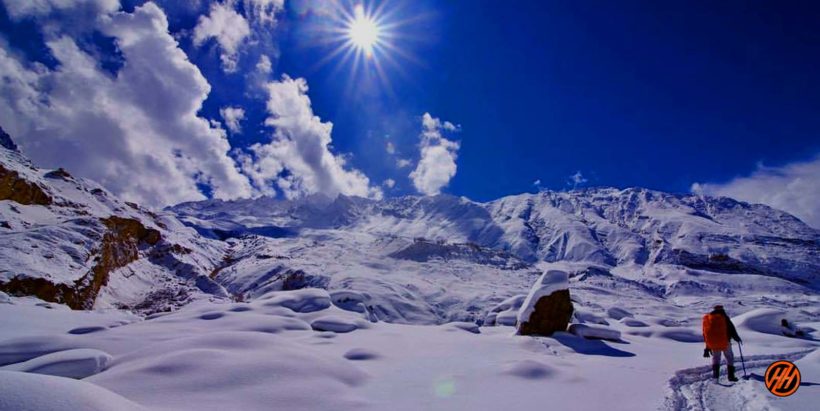
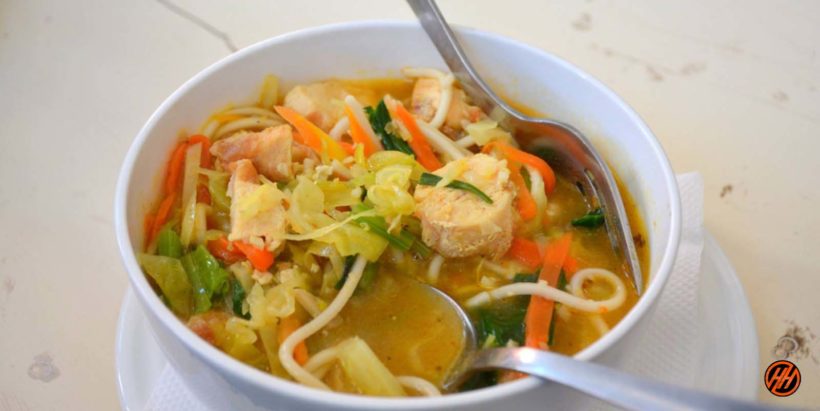
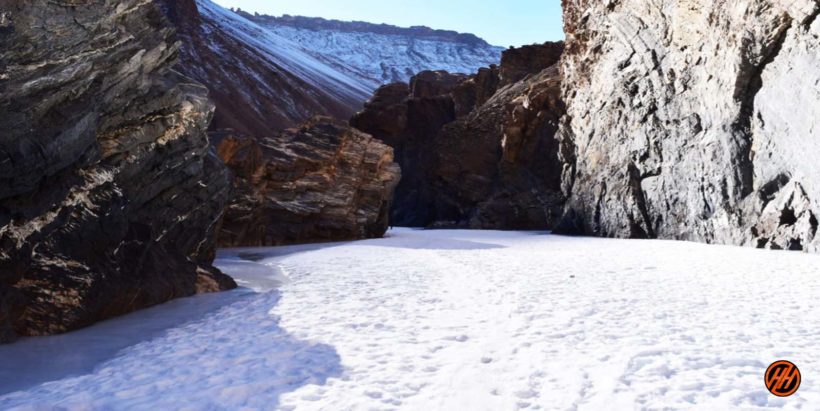
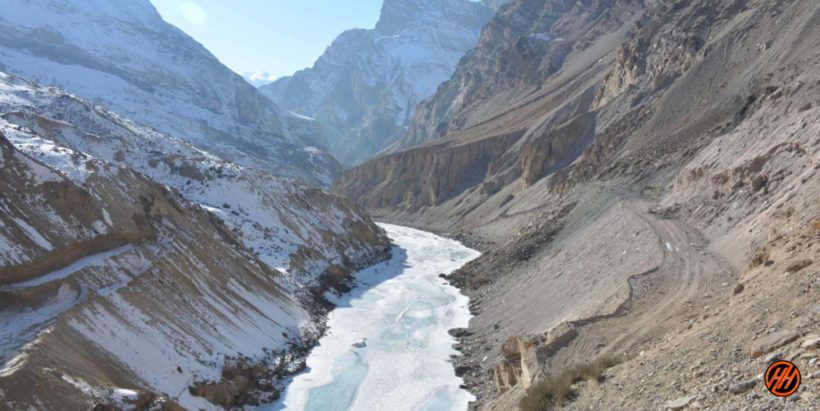
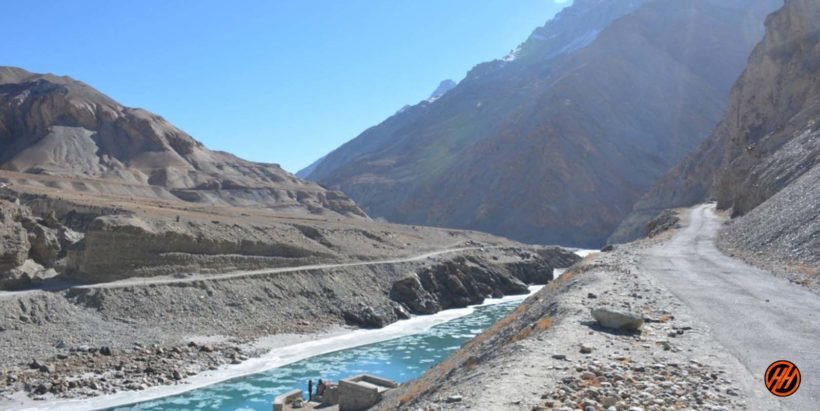
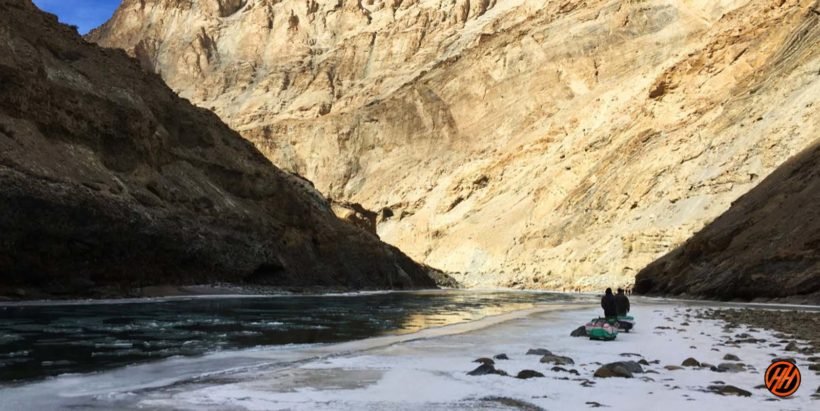
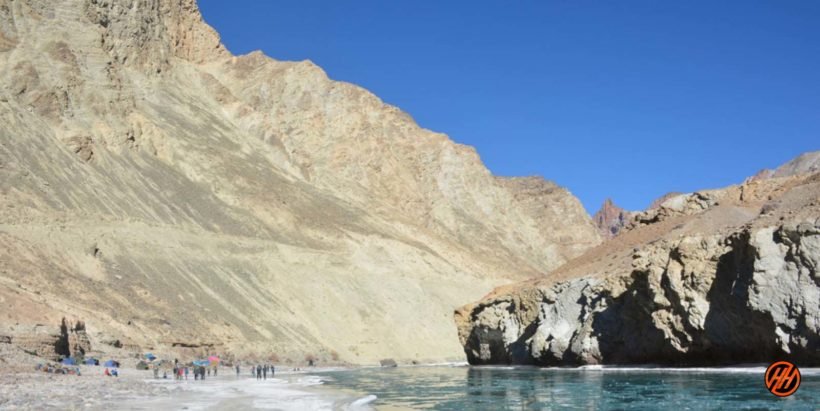
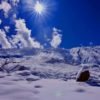

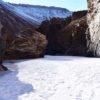
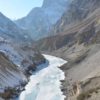
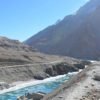
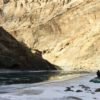
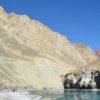
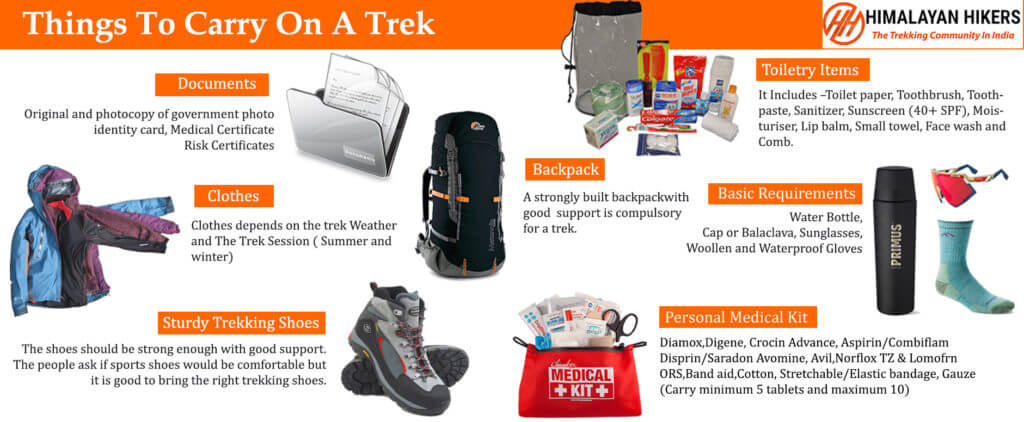


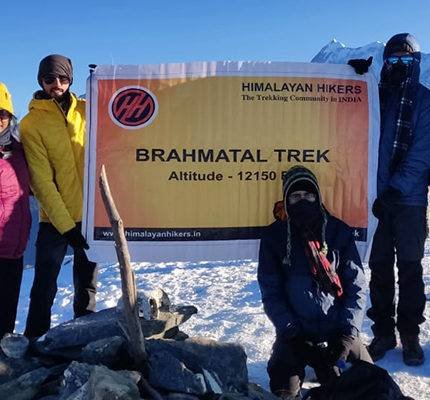
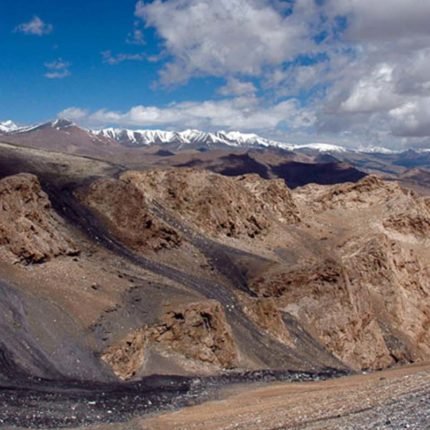
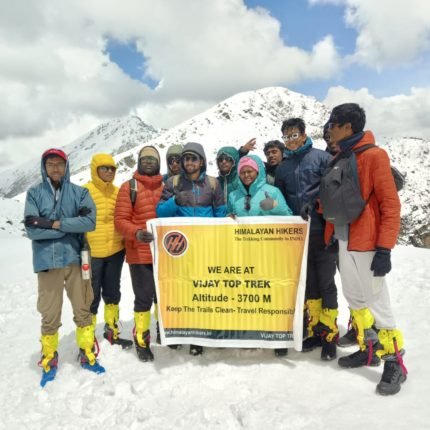
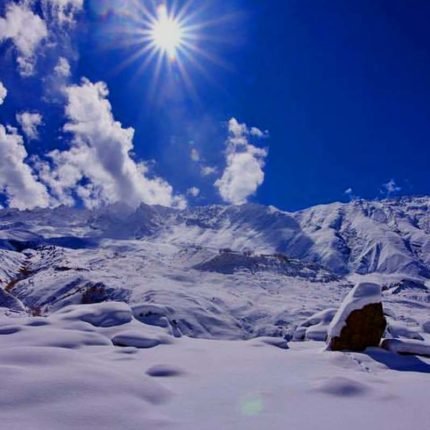
Darshan Shah –
Good
Darshan Shah –
Please information us about this trek
admin –
Okay sure, Can you please contact or WhatsApp us at 9756197558 and Main us at [email protected]